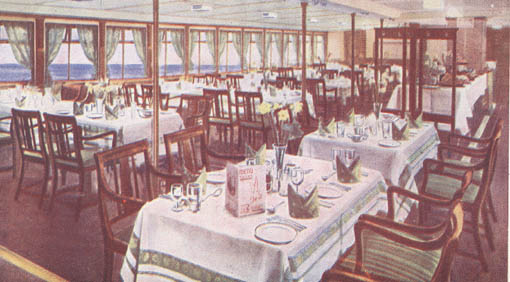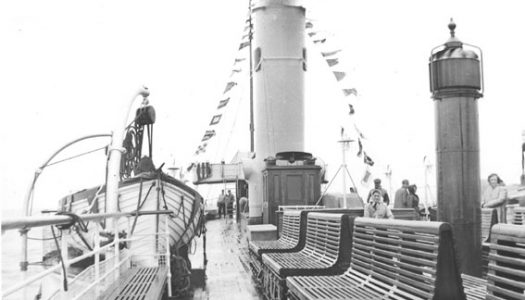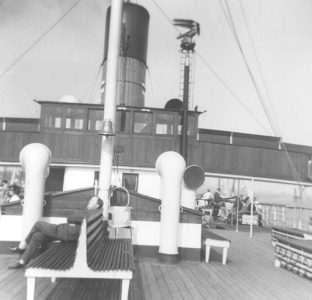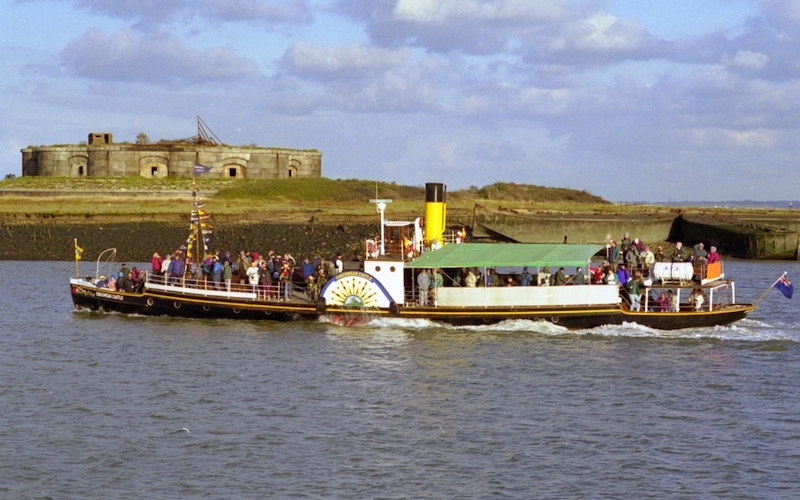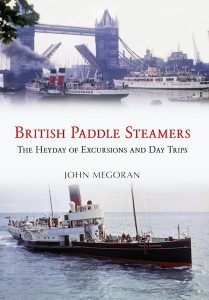 The history of paddlers north and south of the border is given a personal slant by the former master of Kingswear Castle. Review by Iain MacLeod.
The history of paddlers north and south of the border is given a personal slant by the former master of Kingswear Castle. Review by Iain MacLeod.
I’m sure that many CRSC members share my affection for the book which gave us all a ‘closer looking’ at the steamers as they were before our time – ‘the passengers, the personnel, the intimate everyday things, and the little generous touches … that spoke of a more gracious age – trifles, but things we love to remember’. I remember discovering Cameron Somerville’s ‘Colour on the Clyde’ on the station bookstall at Gourock and plunging straight into it as I crossed to Dunoon on the open deck of an ABC car ferry. Years later, it is still a treasure.
Now, John Megoran’s delightful book offers more of the same: but it roams more widely among the paddlers of the whole British coast, telling of successes and failures, anecdotes and accidents, captains and enthusiasts.
The book has its origins in a regular ‘Pictures of the Month’ web page – and its one weakness is that the photographic reproduction online was often rather better than Amberley have managed in the printed version. But there’s still a fine range of subjects for the 38 short and profusely illustrated chapters into which the book is divided. ‘Fog’, for example, is followed by ‘Rescues’ and then ‘Breakdowns’; after a ‘Scarborough Bust-Up’ come the ‘Thames Toffs’; we are taken aboard Monarch in the 1920s and Consul more than 40 years later; we get a flavour of the Sussex Coast, of Torquay, of Bournemouth.
CRSC readers will be particularly interested in the account of Jeanie Deans’ last season in her native waters and perhaps above all in the chapter of accidents that was the Jeanie’s voyage south – for the first part of which a fortunate and wide-eyed 14-year old Megoran was aboard. I was also that sort of age at the time, but my involvement was much less exciting, confined to my father’s prescience in filming the Jeanie at Rothesay in 1964 and telling me knowingly that she wouldn’t be around for much longer.
The book offers plenty more of Clyde interest, including pictures of the Humber steamers, the last of them the Inglis-built Lincoln Castle. As a schoolboy and student, they were my ‘local’ paddlers, for I could reach them from home for an afternoon’s crossing from Hull to New Holland and back. It was scarcely the most scenic of routes, but the boats were coal-fired and it was fascinating to see the car-carrying operation at work, so different in the 1970s from the way things had evolved on the Clyde. The book brings us Medway Queen, too, built by Ailsa at Troon: I was on board her only once, when she was what would nowadays be called a ‘venue’ on the Isle of Wight, so it is good to see her in the pages of this book doing what she was built to do, her decks busy with day trippers.
And that’s true of so many other paddlers from areas less familiar to us than our own. Their memories are evoked through photographs and text in a way which really brings it home to me how much I missed by reaching my teenage years just as paddle steamers were heading into what seemed like an irreversible decline.
Of course it was great to enjoy our Clyde paddlers when the family holidayed on Arran or at Dunoon – and I did manage to get aboard Ryde, the last of the Isle of Wight paddlers. The likes of Consul and Princess Elizabeth, though, were far beyond my reach on the far-away South Coast, and even Bristol Queen and Cardiff Queen had disappeared before I was adventurous enough to travel to the Bristol Channel.
John Megoran brings these ghosts of the sixties fleetingly back to life. He tells us, too, about paddlers from more distant eras – and about steamers overtaken by change like Royal Eagle, built as so many of our favourites were in the 1930s but destined to sail for just 13 seasons. Her glorious dining saloon is in the book and the vastness of her engine-room.
And yes, we meet the people without whom the paddle steamers could not have sailed. John Megoran is one of those himself, but here are the passengers of another age and the captains, entrepreneurs and managers who ran the boats which took them to sea in ‘the heyday of excursions and day trips’. The last hoorah of the paddlers saw men like Herbert Jennings, Edmund Rhodes and Don Rose doing what they could to stem the tide of decline, ultimately in vain. It fell to a later generation to achieve the seemingly impossible and keep Kingswear Castle and Waverley sailing.

John Megoran (right) receiving the Transport Trust Lifetime Achievement Award from Prince Michael of Kent in June 2015 (PSPS)
For me, what really sets John Megoran’s book apart is the glimpses it offers of the way things were, seen through the expert eyes of an author whose qualifications for the task are perhaps unique.
He clearly relishes hunting in the archives for quirky and appealing paddle steamer stories and his youthful memories are enthusiastic and clear. He also writes with a wry sense of humour that will often raise a smile or a nod of recognition.
But John Megoran is Captain Megoran, no armchair enthusiast but a living and breathing paddle steamer skipper who knows what he is talking about when he tells of riding posts, dollies, difficult piers, stern fetching and the rest. We laymen can learn a lot by reading this book.
Someone, one day, will write the definitive and unvarnished history of the paddle steamer preservation movement in Britain. Heroes will be celebrated and the self-effacing John Megoran will take his rightful place amongst them, honoured for the towering role he has played in safeguarding Kingswear Castle and for the practical and thoughtful advice and experience he places at Waverley’s disposal. But now is the time to thank him for sharing with us ‘British Paddle Steamers’, an entertaining and wide-ranging collection of discoveries, delights and insights.
‘British Paddle Steamers — The Heyday of Excursions and Day Trips’ by John Megoran is published by Amberley Publishing and costs £11.69 www.amberley-books.com/current-month/british-paddle-steamers.html
Iain MacLeod was editor of ‘Clyde Steamers’ from 1991 to 2007, and CRSC president for the 1988-9 and 2008-9 sessions.













